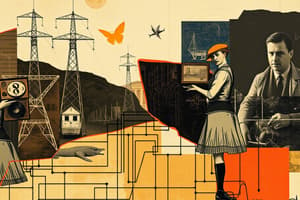Podcast
Questions and Answers
What is the main purpose of an electrical circuit?
What is the main purpose of an electrical circuit?
- To generate heat
- To prevent the flow of electricity
- To deliver energy along a closed loop (correct)
- To create a spark
In an electric circuit, what is the role of insulating material?
In an electric circuit, what is the role of insulating material?
- To increase the flow of current
- To enhance resistance in the circuit
- To amplify power output
- To prevent short circuits (correct)
Which component is typically represented by a plus (+) sign in a basic circuit?
Which component is typically represented by a plus (+) sign in a basic circuit?
- Resistor
- Switch
- Light bulb
- Battery (correct)
What are the three essential principles at the heart of every functioning circuit?
What are the three essential principles at the heart of every functioning circuit?
What is the role of a load in an electric circuit?
What is the role of a load in an electric circuit?
How does complexity affect the variety of configurations in electric circuits?
How does complexity affect the variety of configurations in electric circuits?
What is the fundamental component that determines the flow rate and direction of electric current?
What is the fundamental component that determines the flow rate and direction of electric current?
Which unit is used to measure resistance in electrical circuits?
Which unit is used to measure resistance in electrical circuits?
According to Ohm's Law, what is the relationship between voltage, current, and resistance?
According to Ohm's Law, what is the relationship between voltage, current, and resistance?
Which rule states that the sum of currents entering a junction must equal the sum of currents leaving the intersection?
Which rule states that the sum of currents entering a junction must equal the sum of currents leaving the intersection?
Which quantity is the product of voltage and current in an electrical circuit?
Which quantity is the product of voltage and current in an electrical circuit?
What does Amperes measure in an electrical circuit?
What does Amperes measure in an electrical circuit?
Flashcards are hidden until you start studying
Study Notes
Electric Circuits: Unraveling the Flow of Electricity
Electric current is what brings power into our homes, keeps devices running, and illuminates our world. As we delve deeper into understanding electric circuits—the foundation of this electrified universe—we'll uncover how electricity flows along paths made up of wires and components, delivering energy wherever it's needed.
An electrical circuit can best be thought of as a closed loop through which an electrically charged particle—an electron or ion—flows constantly, carrying energy with each journey around the route. Each pathway within a circuit consists of one or more conductive elements connected by insulating material to prevent unwanted short circuits. These elements include wires, batteries, resistors, capacitors, switches, light bulbs, and other components.
Circuit Types
A simple, basic circuit contains only two main components: a battery or any voltage source, usually represented by a plus (+) sign, and a load, typically symbolized by a minus (-) sign. This configuration forms a closed loop to allow continuous flow. As complexity grows, so too do the possibilities; there exists a plethora of configurations designed to achieve specific outcomes like regulated voltages, controlled current, timing mechanisms, and signal processing.
Voltage, Resistance, and Power
At the heart of every functioning circuit lie three essential principles: voltage, resistance, and power. A fundamental component in determining the flow rate and direction of electric current is voltage, expressed in volts (V), also known as potential difference or electromotive force. It sets the level of pressure guiding the movement of charge throughout a circuit. On the other hand, resistance governs how freely those charges pass through materials and components, measured in ohms (Ω).
The product of voltage and current results in power, often quantified as watts ((W)). By manipulating these variables, technologists engineer circuits capable of performing myriad functions ranging from sending signals over vast distances to generating lightning bolts.
Amperes, Ohm's Law, and Kirchhoff's Rules
Current strength is conveyed via amperes (A); increasing the number of moving particles passing a given point increases the ampere value. Meanwhile, Ohm's Law offers the relationship among voltage, current, and resistance: (V=I \times R), where I stands for current and R represents resistance.
Two rules formulated by Gustav Robert Kirchhoff guide engineers in their endeavor to understand complex circuit behavior:
- Junction Rule: The sum of currents entering a junction must equal the sum of currents leaving the intersection.
- Loop Rule: The algebraic sum of changes in voltage around a completed loop is zero.
These guidelines serve as the cornerstones upon which countless electronic designs have been built since their discovery in the mid-nineteenth century.
As you embrace your curiosity about conducting circuits, remember that they are the lifeblood of modern technology, driving innovation and transforming our daily lives.
Studying That Suits You
Use AI to generate personalized quizzes and flashcards to suit your learning preferences.




